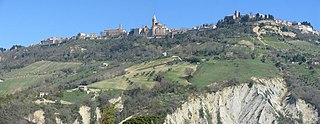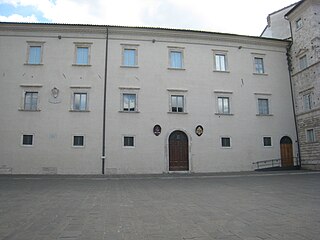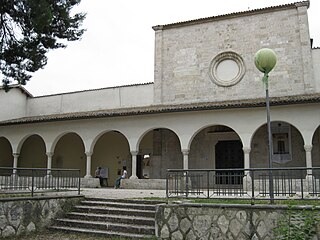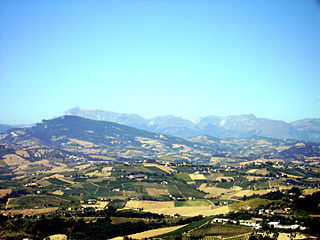History
The piazza's name comes from the Middle Ages when Ascoli became a free comune and used this site for public meetings of the parliament, also known as arringhi, arenghi or arringhe: an assembly of citizens gathered to deliberate. This became the most important center of public events and social life of the city, and several authors name it as the place of the ancient Roman forum of Ascoli.
Giuseppe Marinelli says that in 1152 a platform was erected in the piazza that would be used by public speakers. It was here that St. Francis of Assisi, in 1215, and later St. James of the Marches (in 1446 and 1471) spoke to the citizens of Ascoli.
In 1355, after the expulsion of Galeotto I Malatesta and Vanni di Vendibene, the Statues of the People were drawn up to replace the Statues of the Comune.
In the middle ages at the center of the piazza was a gigantic elm tree. The administrators of the town would come together underneath the tree to discuss town business. From Francesco Bartonini d'Arquata's chronicles of Ascoli, we learn that on February 7, 1369 the great elm was blown down in a great storm that hit the city. Bartolini wrote: «cecidit ulmus maxima et antiquissima, quae stabat in arengho». The tree was replaced by a new one which had to be replaced in 1373. Documents of the era speak of this last tree up until the end of the 15th century. The tree remained there for about a century, but when this one died it was not replaced.
The piazza has been used for military parades, games, and tournaments related to religious festivals linked to the city's patron saint, Saint Emygdius. Among these it is worth mentioning that of 1462, made famous by the victory of the noble woman, Menichina Soderini, who beat Ludovico Malvezzi of Bologna in a horse riding competition.
In 1882 Nicola Cantalamessa made a sculpture of King Victor Emmanuel II which was placed in the piazza. After the second world war the statue of the king was removed and can now be seen in the public gardens.
Today in the piazza two elliptical fountains made of travertine can be found. They were made by Giovanni Jecini and embellished with bronze sculptures by Giorgio Paci.

Jacopo della Quercia, also known as Jacopo di Pietro d'Agnolo di Guarnieri, was an Italian sculptor of the Renaissance, a contemporary of Brunelleschi, Ghiberti and Donatello. He is considered a precursor of Michelangelo.

Ascoli Piceno is a comune (municipality) and capital of the province of Ascoli Piceno, in the Marche region of Italy.

Piazza del Duomo is the main piazza of Milan, Italy. It is named after, and dominated by, Milan Cathedral. The piazza marks the center of the city, both in a geographic sense and because of its importance from an artistic, cultural, and social point of view. Rectangular in shape, with an overall area of 17,000 m2, the piazza includes some of the most important buildings of Milan, as well some of the most prestigious commercial activities, and it is by far the foremost tourist attraction of the city.

Comacchio is a town and comune of Emilia Romagna, Italy, in the province of Ferrara, 48 kilometres (30 mi) from the provincial capital Ferrara. It was founded about two thousand years ago; across its history it was first governed by the Exarchate of Ravenna, then by the Duchy of Ferrara, and eventually returned to be part of the territories of the Papal States. For its landscape and its history, it is considered one of the major centres of the Po delta.

Ripatransone is a comune (municipality) in the Province of Ascoli Piceno in the Italian region Marche, located about 70 kilometres (43 mi) southeast of Ancona and about 20 kilometres (12 mi) northeast of Ascoli Piceno.
Cesa is a comune (municipality) in the Province of Caserta in the Italian region Campania, located about 15 kilometres (9 mi) north of Naples and about 14 kilometres (9 mi) southwest of Caserta.

Foligno Cathedral is a Catholic cathedral situated on the Piazza della Repubblica in the center of Foligno, Italy. The cathedral, built on the site of an earlier basilica, is dedicated to the patron saint of the city, the martyr Felician of Foligno, who was buried here in 251 AD. It is the seat of the Bishop of Foligno. It contains the cathedra for the Diocese of Foligno.

Palazzo dell'Arengo is a monumental palace located on Piazza Arringo, also called Piazza dell'Arengo, in the town-center of Ascoli Piceno, Marche, central Italy. The facades of the Duomo of Ascoli Piceno, the Baptistry of San Giovanni Battista, and the Episcopal palace also face the square, which is now decorated with two oval fountains.

Sant'Oliva is a catholic church located in Alcamo, province of Trapani, Sicily, southern Italy.

Ripatransone Cathedral is a Roman Catholic cathedral and minor basilica in the town of Ripatransone, province of Ascoli Piceno, region of Marche, Italy. It is located on Piazza Ascanio Condivi. The cathedral is dedicated to Saint Gregory the Great and to Saint Margaret. It was formerly the episcopal seat of the Diocese of Ripatransone but is now a co-cathedral in the Diocese of San Benedetto del Tronto-Ripatransone-Montalto.

The Diocesan Museum in the Italian town of Ascoli Piceno is located in one wing of the ecclesiastical palazzo, which also contains the city's pinacoteca and the state archeological museum.

The Ascoli Piceno Baptistery, also known as the baptistery of Saint John, is a religious building found on the eastern end of the piazza Arringo at the center of Ascoli Piceno and sitting next to and just north of the cathedral dedicated to St. Emygdius, the city's patron saint.
The following is a timeline of the history of the city of Pisa in the Tuscany region of Italy.
The following is a timeline of the history of the city of Prato in the Tuscany region of Italy.

Santissima Annunziata was a Roman Catholic church dedicated to the Annunciation in Ascoli Piceno, Italy. It is located in the Parco dell'Annunziata. The whole complex was the result of extensions to an original 13th century set of buildings.

The Jewel of Vicenza was a silver model of the city of Vicenza made as an ex-voto in the 16th century and attributed to the architect Andrea Palladio. The Jewel was stolen by the Napoleonic army during the Italian Campaign in the French Revolutionary Wars and subsequently destroyed. A copy was created between 2012 and 2013.

Piazza Dante is the main public square in Grosseto, Tuscany, Italy.

Mount Ascensione is a 1,110 m high elevation in the Marche sub-Apennines, located entirely in the province of Ascoli Piceno. It straddles the valleys of Tronto and Tesino, a river that originates just north near Force. The profile of Ascensione has a jagged appearance that suggests different figures: depending on the vantage point, it may resemble the Sleeping Beauty or the profile of Cecco d'Ascoli, a heretic and opponent of Dante Alighieri. The views from the east northeast and from the west southwest are perfectly symmetrical.




















